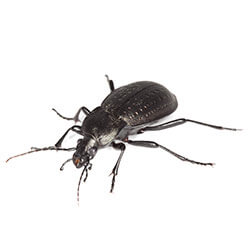Identification
- Colour Black or dark in colour, with metallic hues of blue, green, orange, red, yellow, or copper
- Size From 2 mm to 25 mm long
- Description Oval and elongated, with three pairs of legs and two pairs of wings. These beetles also have prominent mandibles.

What do ground beetles look like
Ground beetles vary in size and shape but most are oval and elongated. They range in size from about 2 to 25 mm or more in length. Most species are black or otherwise dark in colour, though certain types of ground beetles feature an iridescent quality characterized by metallic hues of blue, green, orange, red, yellow, copper, or a combination thereof. Like other insects, the body is divided into three body parts: head, thorax, and abdomen. They have three pairs of legs and two pairs of wings, with the outer wings hardened into elytra used as protective covers. Because most are predators, they have prominent mandibles for capturing and devouring their prey. In fact, ground beetles can be identified and distinguished from similar-looking species by their ability to run quickly and their tendency to scurry for cover when disturbed.
Habitat, Diet, Lifestyle/Reproduction
Habitat
Ground beetles live and breed in the soil. True to their name, the insects are regularly found on the ground under logs, rocks, wood, leaves, boards, and other debris. Ground beetles commonly reside in agricultural zones, such as fruit orchards, and rank as the most frequently encountered type of beetle in the yards and gardens of many Canadian provinces. When the pests move indoors, they can often be found hiding in damp basement areas or under objects on the floor. Most ground beetles are nocturnal creatures that remain hidden during the day. Although they invade buildings from time to time, ground beetles only reproduce outdoors.
Diet
Widely regarded as beneficial insects due to their eating habits, ground beetles are predators which feed on common invertebrate pests such as ants, aphids, caterpillars, maggots, slugs, and worms. Some species, such as the caterpillar hunter, focus on a particular food source exclusively, while others are generalist feeders. Certain ground beetle species even demonstrate phytophagous tendencies by preying on the seeds, shoots, and pollen of plants rather than feeding on other animals. Some ground beetles can eat as much as four times their own body weight in prey on a daily basis.
Life Cycle/Reproduction
Ground beetles develop and mature by undergoing complete metamorphosis from egg to adult. Females typically produce one generation of offspring each year and lay their eggs individually in the soil. A single litter of ground beetles contains 30 to 600 offspring that hatch from the eggs as larvae and usually complete three larval instars before pupating. Ground beetles emerge as adults shortly after completing the pupal stage of the life cycle, which occurs in the soil and is rarely witnessed. Full development from egg to adulthood can take place within a single season. Adult ground beetles typically live for one to four years and are usually most active between the months of April and October.
Why do I have ground beetles
There are more than 800 species of ground beetles in Canada alone, making them the most frequently encountered beetles in yards and gardens.
They usually live in the soil under logs, rocks, wood, leaves, boards, and other debris in agricultural areas like fruit orchards, eating garden pests and plants. They are very active at night.
However, they are attracted to light and in summertime can congregate around well-lit homes and businesses, before entering all at once and creating an infestation.
They gain access through cracks, crevices, and other small openings, and can be found hiding in damp basement areas or under objects on the floor.
How worried should I be about ground beetles
Ground beetles actually have many benefits, preying on garden pests like ants, aphids, caterpillars, maggots, slugs, and worms.
However, some ground beetles eat the seeds, shoots, and pollen of plants, even eating seeds of corn, potentially destroying a harvest.
These beetles can cause alarm when they enter buildings, and some can release odorous secretions. But they do not reproduce indoors, pose a health threat, or damage property.
While smaller infestations of ground beetles can be vacuumed up, captured in a container, or caught in sticky traps, larger infestations require the help of a professional pest control, to ensure the proper application of insecticide and to prevent the pests coming back.
How can I prevent ground beetles invading
Ground beetles often gain access to buildings through cracks, crevices, and other small openings, repairing and sealing these potential entry points will help keep the pests from invading. Other ways to prevent a ground beetle infestation include keeping mulch away from the building foundation and either reducing the level of outdoor lighting within the immediate vicinity of the structure or using yellow light bulbs instead of bright white ones. Furthermore, the yard should remain free of rocks, stones, wood, boards, leaves, and other debris under which ground beetles typically like to live.
Other pests related to Ground Beetles
100% Satisfaction or Money Back Guarantee
Resolving your pest problem is our #1 priority. If re-treatment is required, we'll provide immediate services at no extra cost. If your expectations are not met, we guarantee a full refund of your service payment.
Remove pests from your home, and stop them from coming back
We work hard to listen, understand and assess your unique situation. Request a free, no-obligation estimate today for a customized pest program that fits your needs.
Request a Free Home EstimateRequest a Free Business Consultation

